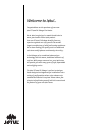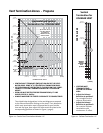
8
Vent Restriction
The GF 400 DV Sebago is equipped with Restrictor Plates
which enable you to regulate the flow of incoming
combustion air and exhaust gas. The plates prevent
overly strong draft that can cause poor combustion and
weak flame picture. Follow the guidelines below, and on
the following pages, to determine the correct restrictor
plate setting for your particular installation configura-
tion.
Intake Air Restrictor
This plate is located at the rear of the firebox behind the
burner plate. It is set in a CLOSED position at the factory
and should be left there for most vent configurations.
It should be opened only for snorkel terminations and
some short run horizontal terminations as specified on
the following pages. To adjust the Air Restrictor to the
OPEN position, locate and loosen the wing nut under the
burner and push it back as far as it will go. See Fig. 6.
Exhaust Restrictor
The Exhaust Restrictor is an adjustable shutter located at
the top of the firebox. It is adjusted by moving a pivot
pin into one of four positions. It is set in the FULLY OPEN
position at the factory. See Fig. 7.
Use the chart in Table 1 to determine the correct
position for your installation and follow the instructions
below to adjust it if necessary.
Additional restriction may be needed depending the
overall vent height. Use Simpson Dura-Vent Restrictor
Disk #929.
Adjusting Exhaust Restrictor Plate:
1. Remove the Top Plate.
2. Locate the pivot pin at the left side of the firebox top.
Loosen the wing nut on the pivot pin and push the pin
to the left to disengage it from the current setting
position. Move the pin toward the rear and then right
to engage it in the appropriate position indicated on
the firebox. See fig. 7.
3. Tighten the lock nut and replace the Top Plate.
Venting Requirements
The Jøtul GF 400 DV Sebago gas stove may be installed
with a vertical or horizontal termination and must
conform to the configuration requirements described
below.
This appliance is approved for use with vent systems
from the following manufacturers:
• Simpson Dura-Vent GS
• Amerivent Corporation
• Security Vent Ltd.
• Selkirk Metalbestos
Use parts of one manufacturer only - DO NOT MIX
VENT COMPONENTS FROM DIFFERENT MANUFACTURERS
IN THE SAME SYSTEM.
Installation of any components not manufactured or
approved by Jøtul or failure to meet all clearance require-
ments will void all warranties and could result in prop-
erty damage, bodily injury, or serious fire.
The approved vent configurations described in this
manual are derived from extensive testing under con-
trolled laboratory conditions. Gas appliance performance
can be negatively affected by variables present in the
installation environment, i.e: atmospheric pressure,
strong prevailing winds, adjacent structures and trees,
snow accumulation, etc. These conditions should be
taken into consideration by the installer and stove owner
when planning the vent system design.
IMPORTANT
• JOINT SEALING REQUIREMENT: APPLY A 1/8” BEAD OF
HIGH-
TEMPERATURE (750°F) SEALANT TO THE MALE SEC-
TION OF THE INNER VENT PIPE. THE CEMENT SHOULD
FORM A SEAL BETWEEN THE INNER
AND OUTER PIPES.
• NEVER MODIFY ANY VENTING
COMPONENT, OR USE ANY DAM-
AGED VENTING PRODUCT.
• THE GAS APPLIANCE AND VENT
SYSTEM MUST BE VENTED
DIRECTLY TO THE OUTSIDE OF
THE BUILDING AND NEVER
ATTACHED TO A CHIMNEY
SERVING A SOLID FUEL OR
GAS BURNING APPLIANCE.
EACH DIRECT VENT GAS APPLIANCE
MUST HAVE ITS OWN SEPARATE VENT SYSTEM.
COMMON VENT SYSTEMS ARE PROHIBITED.
• IF VENTING SYSTEM IS DISASSEMBLED FOR ANY
REASON, REINSTALL PER THE INSTRUCTIONS PROVIDED
FOR THE INITIAL INSTALLATION.
S
E
A
L
A
N
T
Fig. 5.


















